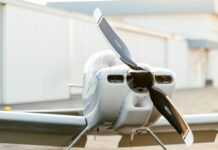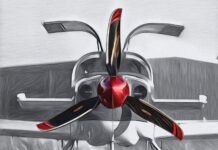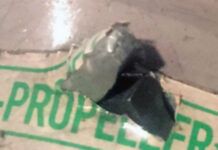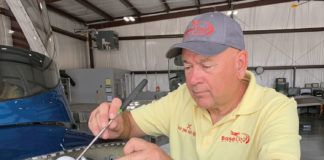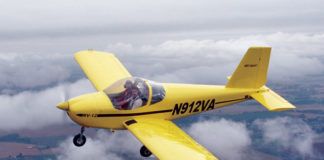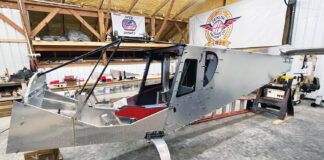With efficiencies above 80%, modern propellers do a good job of converting engine horsepower to thrust. They’re also tough and sturdy, so what could go wrong? Not much, as it turns out. But every prop needs care. With that in mind, let’s look at a list of the top prop-care fundamentals.
Don’t Hit Anything—Not Even Grass
This seems obvious. A prop strike is defined as an incident causing any reduction in engine rpm. If the nosegear drops in a hole and a prop blade contacts anything, even a clump of bunchgrass, which causes an rpm slowdown as seen on the tachometer, that qualifies as a prop strike. The same goes if the engine rpm is heard to sag. When a strike or complete engine stoppage occurs, the only way to guarantee the airworthiness of the engine is to remove it for a complete teardown and component inspection.

If you pick up a nick or scratch on the prop, it needs to be dressed properly. The smoothly filed repair, on a 10:1 ratio of length:depth, is needed to remove stress risers caused by the nick.
During a sudden slowdown or stoppage, rotating parts, components and accessories concentrate inertial forces on critical components that aren’t designed for the resulting loads. Lycoming Airworthiness Directive (AD) 2004-10-16 defines both sudden stoppage and prop strike. Most insurance policies will fund a portion of the teardown.
Boiled down to basics, any time even one blade of a propeller has been damaged beyond what can be repaired by a simple dressing of the blades, it should be sent to a certified shop for repair, the engine and accessories should be disassembled, and the parts should be inspected for damage. This rule also applies to damage that occurs from ground incidents when the engine is not running, e.g., impact damage from a hangar door or a vehicle hitting the prop.
Don’t Push, Don’t Pull
Here’s one that most pilots violate: You should not use a propeller as a handle to move your airplane. Use a tow bar or areas of the airframe that are designated for pushing and pulling loads. If the tow bar projects into the prop arc when it’s attached to the airplane, remove it after each move lest it becomes a whirling weapon zinging across the ramp.
Cleanliness Counts
Propeller blades will deteriorate if not kept clean and dry. McCauley Propellers warns owners against using water to clean blades unless absolutely necessary and also advises against letting water run into the hub. Blades can be protected from corrosion by wiping the leading edges with a light coat of oil or by applying a light coat of a product such as LPS 2 lubricant. The rag used to wipe the engine oil dipstick clean during oil-level checks often has enough residual oil to coat the leading edges.
Rocks and Nicks
Nicks in the prop from rocks or other debris cannot be ignored. In the leading edge they tend to focus stress, causing stress risers that lead to cracks and blade failures. A Cessna customer information letter dated November 25, 1991, provides the following guidance for completely removing nicks: File strokes must run from the blade shank to blade tip. Use a fine-cut file to create gradual slopes that begin at a distance on each side of the nick equal to five times the depth of the nick. This will create a blended, smoothly sloped repair that is 10 times as wide as the depth of the nick. Polish the repaired area with 00 sandpaper or crocus cloth.
Have a Look Inside
According to information from Hartzell, centrifugal forces exerted on a typical light-airplane propeller blade during operation are between 30,000 and 50,000 pounds. The hub, blades and bearing parts are designed to handle these loads and provide good service as long as there is no corrosion or damage.
The possibility of corrosion and rust on the load-bearing parts within the hub is why every light-airplane propeller should be sent to a prop shop on a regular basis for an internal inspection. Opinions vary as to how often these inspections are required, because factors such as frequency and effectiveness of servicing, use history and environmental factors affect the onset and speed of corrosion and deterioration. Manufacturers recommend overhauling at five-year and 2000-hour intervals.
Money-prudent owners should be aware of the difference in cost between a procedure called a propeller re-seal and a propeller overhaul. Both operations start the same way—by removing the blades from the hub. At this point the propeller technician cleans the parts and inspects them to determine their condition. If the parts are corrosion-free with no evidence of damage, new seals are installed and the propeller is reassembled. If not, the shop will prepare an estimate of the cost to return the propeller to airworthy status. Cost? Between $500 and $1000.
When a propeller is sent to a certified propeller service center for an overhaul, the shop is required to inspect every part—which requires specialized non-destructive testing equipment—to complete all the steps mandated by the propeller manufacturer for a complete overhaul. This takes more time and, obviously, more money. A rough estimate for an overhaul ranges from $2000 to $3000. Propellers must be inspected internally on a regular basis.
Lubrication
Each propeller has different lubrication requirements. Always consult the correct service manual for the propeller lubrication procedures and type of lubrication. Hartzell constant-speed propellers are serviced through two grease fittings, called zerk fittings, that project at right angles from the hub at the base of each blade. Hartzell specifies a one-year or 100-hour service interval, whichever occurs first. One zerk fitting is removed—Hartzell recommends removing the fitting nearest the trailing edge of the blade in tractor installations and nearest the leading edge of the blade in pusher installations—and 1 fluid ounce of grease is pumped into the hub at each blade. The grease type (Aeroshell 6, for example) will be specified on a label on the hub. For the few of you running a McCauley prop, understand that this company’s constant-speed propeller hubs do not require any field lubrication servicing. McCauley props are filled with red 10-weight oil, which serves two purposes: It lubricates, and it provides leak detection. Any red oil that appears on the cowling, hub or spinner area of the propeller must be investigated before further flight, because the leakage may indicate a hub crack or blade-seal failure.
Are You on Track?
Checking blade track is simple and should be done at each condition inspection, or whenever an unusual or new vibration pattern is felt. Here’s how it’s done: Remove the most accessible spark plug from each cylinder. Doesn’t matter which one—the goal is to vent the compression so the propeller will rotate easily. Then rotate each blade of the prop past a stable point while measuring the distance each blade is from that point. Many manuals illustrate this with drawings of a long board or dowel with one end attached to the airframe so that the other is within a short distance of the prop track, though I’ve never seen this method used. What is more common is to measure the distance of each blade as it’s moved past the edge of a common shop tool such as a milk carton or step stool that’s positioned close to the trailing edge of the blade as it’s rotated. Any differential greater than 1⁄16 inch (0.0625 inch or 1.58mm) between blades must be investigated.







